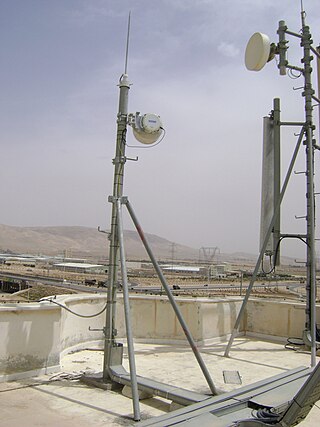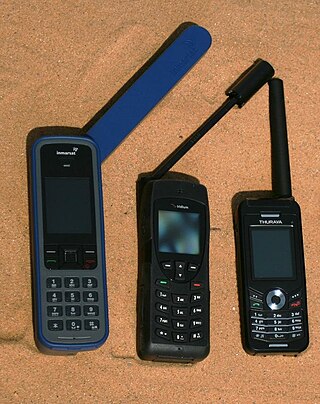
A wireless network is a computer network that uses wireless data connections between network nodes.

DISH Network Corporation is an American television provider and the owner of the direct-broadcast satellite provider Dish, commonly known as Dish Network, and the over-the-top IPTV service, Sling TV. Additionally, Dish offers mobile wireless service, Dish Wireless. On July 1, 2020, Dish acquired prepaid service Boost Mobile and intends to add postpaid service as well in the future. Based out of unincorporated Douglas County, Colorado the company has approximately 16,000 employees.

Ultra high frequency (UHF) is the ITU designation for radio frequencies in the range between 300 megahertz (MHz) and 3 gigahertz (GHz), also known as the decimetre band as the wavelengths range from one meter to one tenth of a meter. Radio waves with frequencies above the UHF band fall into the super-high frequency (SHF) or microwave frequency range. Lower frequency signals fall into the VHF or lower bands. UHF radio waves propagate mainly by line of sight; they are blocked by hills and large buildings although the transmission through building walls is strong enough for indoor reception. They are used for television broadcasting, cell phones, satellite communication including GPS, personal radio services including Wi-Fi and Bluetooth, walkie-talkies, cordless phones, satellite phones, and numerous other applications.

A very-small-aperture terminal (VSAT) is a two-way satellite ground station with a dish antenna that is smaller than 3.8 meters. The majority of VSAT antennas range from 75 cm to 1.2 m. Bit rates, in most cases, range from 4 kbit/s up to 16 Mbit/s. VSATs access satellites in geosynchronous orbit or geostationary orbit to relay data from small remote Earth stations (terminals) to other terminals or master Earth station "hubs".
In United States regulatory law, an unintentional radiator is any device that is designed to use radio frequency electrical signals within itself, or sends radio frequency signals over conducting cabling to other equipment, but is not intended to radiate radio frequency energy. An incidental radiator is a device that can generate radio frequency electrical energy even though it is not intentionally designed to do so. Unintentional and incidental radio frequency radiation can interfere with other electronic devices. In the United States, limits on radiated emissions from unintentional and incidental radiators are established by the Federal Communications Commission. Similar regulations have been promulgated by other governments. Reference is usually made in regulations to technical standards established by organizations such as ANSI, IEC and ITU.
The S band is a designation by the Institute of Electrical and Electronics Engineers (IEEE) for a part of the microwave band of the electromagnetic spectrum covering frequencies from 2 to 4 gigahertz (GHz). Thus it crosses the conventional boundary between the UHF and SHF bands at 3.0 GHz. The S band is used by airport surveillance radar for air traffic control, weather radar, surface ship radar, and some communications satellites, especially those used by NASA to communicate with the Space Shuttle and the International Space Station. The 10 cm radar short-band ranges roughly from 1.55 to 5.2 GHz. The S band also contains the 2.4–2.483 GHz ISM band, widely used for low power unlicensed microwave devices such as cordless phones, wireless headphones (Bluetooth), wireless networking (WiFi), garage door openers, keyless vehicle locks, baby monitors as well as for medical diathermy machines and microwave ovens. India's regional satellite navigation network (IRNSS) broadcasts on 2.483778 to 2.500278 GHz.
The V band ("vee-band") is a standard designation by the Institute of Electrical and Electronics Engineers (IEEE) for a band of frequencies in the microwave portion of the electromagnetic spectrum ranging from 40 to 75 gigahertz (GHz). The V band is not heavily used, except for millimeter wave radar research and other kinds of scientific research. It should not be confused with the 600–1000 MHz range of Band V of the UHF frequency range.

A satellite telephone, satellite phone or satphone is a type of mobile phone that connects to other phones or the telephone network by radio through orbiting satellites instead of terrestrial cell sites, as cellphones do. The advantage of a satphone is that its use is not limited to areas covered by cell towers; it can be used in most or all geographic locations on the Earth's surface.
Pendrell Corporation is an intellectual property (IP) investment, advisory services and asset management firm. The company develops and implements strategies to acquire, commercialize, manage, divest and license IP. The company, formerly ICO Global Communications, is based in Kirkland, Washington.
Thuraya is a United Arab Emirates-based regional mobile-satellite service (MSS) provider. The company operates two geosynchronous satellites and provides telecommunications coverage in more than 161 countries in Europe, the Middle East, North, Central and East Africa, Asia and Australia. Thuraya's L-band network delivers voice and data services.

Microwave transmission is the transmission of information by electromagnetic waves with wavelengths in the microwave frequency range of 300MHz to 300GHz(1 m - 1 mm wavelength) of the electromagnetic spectrum. Microwave signals are normally limited to the line of sight, so long-distance transmission using these signals requires a series of repeaters forming a microwave relay network. It is possible to use microwave signals in over-the-horizon communications using tropospheric scatter, but such systems are expensive and generally used only in specialist roles.
SkyTerra (SKYT), formerly Mobile Satellite Ventures, was a Reston, Virginia company that developed telecommunications systems that integrate satellite and terrestrial radio communication technologies into one system. In March 2010, the company was acquired by Harbinger Capital Partners and under the leadership of CEO Sanjiv Ahuja became part of a new company called LightSquared. The company placed its first satellite, SkyTerra-1, in orbit on November 14, 2010. LightSquared has since then went bankrupt and emerged from bankruptcy as Ligado Networks.
TerreStar Corporation (TSTR), formerly Motient Corp. and American Mobile Satellite Corp., was the controlling shareholder of TerreStar Networks Inc., TerreStar National Services, Inc. and TerreStar Global Ltd., and a shareholder of SkyTerra Communications.

Fixed wireless is the operation of wireless communication devices or systems used to connect two fixed locations with a radio or other wireless link, such as laser bridge. Usually, fixed wireless is part of a wireless LAN infrastructure. The purpose of a fixed wireless link is to enable data communications between the two sites or buildings. Fixed wireless data (FWD) links are often a cost-effective alternative to leasing fiber or installing cables between the buildings.
EchoStar Mobile, an Irish company with commercial operations headquartered in the United Kingdom and a data centre based in Griesheim, Germany, is a mobile operator that provides connectivity across Europe through a converged satellite and terrestrial network. EchoStar Mobile is a subsidiary of EchoStar Corporation, a provider of satellite communications devices.
TerreStar-1 is an American communications satellite which was operated by TerreStar Corporation. It was constructed by Space Systems/Loral, based on the LS-1300S bus, and carries E/F band transponders which will be used to provide mobile communications to North America. The signals are transmitted by an 18-metre (59 ft) reflector on the satellite. It had a launch mass of 6,910 kilograms (15,230 lb), making it the second most massive single satellite launched into a geosynchronous transfer orbit, and the second largest commercial communications satellite ever built. Its record as the most massive communication satellite was surpassed by Telstar 19V launched on Falcon 9 on July 21, 2018, with a mass of 7,076 kilograms (15,600 lb).
One way of outlining the subject of radio science is listing the topics associated with it by authoritative bodies.

Mobile-satellite service is – according to Article 1.25 of the International Telecommunication Union's Radio Regulations – "A radiocommunication service

The C band is a designation by the Institute of Electrical and Electronics Engineers (IEEE) for a portion of the electromagnetic spectrum in the microwave range of frequencies ranging from 4.0 to 8.0 gigahertz (GHz). However, the U.S. Federal Communications Commission C band proceeding and auction, designated 3.7–4.2 GHz as C band. The C band is used for many satellite communications transmissions, some Wi-Fi devices, some cordless telephones, as well as some Radar and weather radar systems.
RF CMOS is a metal–oxide–semiconductor (MOS) integrated circuit (IC) technology that integrates radio-frequency (RF), analog and digital electronics on a mixed-signal CMOS RF circuit chip. It is widely used in modern wireless telecommunications, such as cellular networks, Bluetooth, Wi-Fi, GPS receivers, broadcasting, vehicular communication systems, and the radio transceivers in all modern mobile phones and wireless networking devices. RF CMOS technology was pioneered by Pakistani engineer Asad Ali Abidi at UCLA during the late 1980s to early 1990s, and helped bring about the wireless revolution with the introduction of digital signal processing in wireless communications. The development and design of RF CMOS devices was enabled by van der Ziel's FET RF noise model, which was published in the early 1960s and remained largely forgotten until the 1990s.








